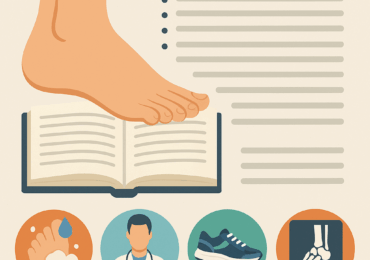Table of Contents
- Introduction
- The Foundations of Foot Health
- Essential Foot Care Tips for Daily Life
- Common Foot Problems and How to Address Them
- The Role of Proper Footwear
- Importance of Exercise for Strong Feet
- Nutritional Tips for Healthy Feet
- When to Consult a Professional
- Technological Advances in Foot Health
Introduction
Foot health is often taken for granted until an issue arises, causing discomfort or limiting mobility. Recognizing and addressing the significance of foot care is essential, as our feet bear the weight of daily activities and, when neglected, can lead to debilitating problems. From understanding the anatomy to keeping up with technological advancements, foot health requires attention and proactive management. Being proactive can often begin with something as simple as a basic search to find a podiatrist near me who is well-versed in addressing various foot concerns. This comprehensive guide will enlighten you with practical tips for maintaining healthy feet.

Every step you take toward maintaining foot health counts. This guide delves into essential aspects, including commonsense hygiene practices, selecting the proper footwear, tackling prevalent foot problems, and the growing role of technology in this domain.
The Foundations of Foot Health
The human foot is a remarkable structure comprising 26 bones, 33 joints, and over 100 muscles, tendons, and ligaments. It is designed to bear full weight and facilitate movement, balance, and shock absorption. When foot health is neglected, your mobility is at risk, but you may also develop secondary issues that affect the knees, hips, and lower back. Thus, it is clear that maintaining foot health involves not just comfort but also a crucial element of an active, healthy lifestyle, enabling individuals to easily perform daily tasks.
Essential Foot Care Tips for Daily Life
Including foot care in your everyday routine is an easy but frequently neglected activity. Begin by washing your feet thoroughly with warm water and mild soap. Ensure you dry them meticulously, especially between the toes, where moisture can foster fungal infections. Daily moisturizing prevents the skin from becoming dry and cracked. Additionally, by keeping your toenails trimmed straight across and not too short, you can reduce the risk of developing painful ingrown toenails. Adopting these simple practices is a proactive approach, avoiding severe problems before they start and keeping your feet in optimal condition.
Common Foot Problems and How to Address Them
Foot issues can arise from various factors, including improper footwear, overuse, or underlying health conditions. Blisters, for example, occur due to friction and can be avoided by using fitting shoes and protective bandages on vulnerable areas. For calluses and corns, gentle filing paired with consistent moisturizing maintains skin smoothness and prevents thickening. Plantar fasciitis, experienced as sharp heel pain, benefits from stretching exercises, massage, and appropriate footwear. Addressing these problems early with simple remedies can spare you from more invasive treatments. Knowing when to elevate these concerns to a professional ensures you give your feet the attention they deserve.
The Role of Proper Footwear
The importance of suitable footwear cannot be overstated. Shoes serve more than an aesthetic purpose; they provide crucial support and protection. Your choice of footwear directly influences your foot health by offering necessary support and cushioning. Choosing shoes that accommodate your foot arch and activity level—a consideration varying from work shoes to athletic gear—can mitigate unnecessary strain. Footwear should fit comfortably, allowing some room for your toes to move and preventing blisters and calluses. Investing time in selecting appropriate footwear pays dividends in terms of long-term foot health and comfort.
Importance of Exercise for Strong Feet
Exercises for the feet are essential for preserving strength and flexibility. Participating in toe lifts, ankle twists, and towel curls fortifies the foot muscles, improving their performance and resistance to injuries. Rolling a tennis or golf ball beneath your foot enhances circulation and reduces tension in the fascia, assisting in relieving plantar fasciitis. Incorporating these exercises into your everyday regimen is easy and efficient, improving balance and stability while promoting pain-free feet.
Nutritional Tips for Healthy Feet
A diet rich in calcium, vitamin D, magnesium, and omega-3 fatty acids supports bone wellness and reduces inflammation, benefiting foot health. Staying hydrated ensures optimal circulation and maintains skin and muscle elasticity. Prioritize foods like leafy greens, nuts, seeds, and fish, as they contribute to keeping your feet in tip-top shape. As highlighted by the CDC’s healthy eating tips, choosing nutritious foods and maintaining a balanced diet is essential for promoting overall well-being. Monitoring your overall nutrition helps ensure that your body, including your feet, can operate at its best.
When to Consult a Professional
Recognizing when professional intervention is necessary for foot health can prevent further complications. Persistent pain, noticeable deformities, infections, or a lack of sensation may require specialized care. Following guidelines from licensed podiatrists offers clarity on when to seek medical advice. These professionals can diagnose and treat foot conditions effectively, tailoring their approaches to meet your needs and intervening before minor issues lead to serious harm.
Technological Advances in Foot Health
Technology keeps progressing in podiatry, providing fresh insights and solutions for preserving foot health. Orthotic insoles have become more sophisticated, giving custom-fit options tailored to one’s unique foot structure. Emerging technology, such as digital gait analysis, allows for precise measurements of how one walks, identifying abnormalities that can be corrected with targeted therapies. The future of foot health promises to introduce even more significant innovations, ensuring that care becomes more personalized and effective, paving the way for healthier, happier feet.